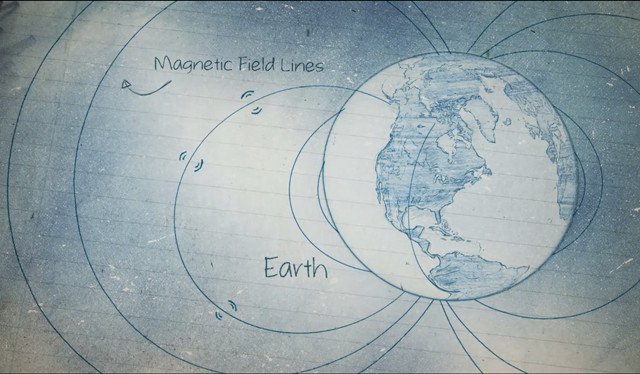
by Lucas Joel Tuesday, March 14, 2017

An illustration of Earth's fluctuating magnetic field lines. Credit: Conceptual Image Lab at NASA's Goddard Space Flight Center/Matthew Radcliff, producer.
As Earth warms, the atmosphere isn’t the only place where temperatures are rising — the oceans are absorbing most of the excess heat, but precisely how much is unclear. Using recently launched satellites that can measure subtle fluctuations in Earth’s magnetic field, researchers are devising a method that may help refine ocean temperature measurements and clarify how much heat the oceans are storing.
“We don’t have adequate measurements of how much ocean temperatures are changing over time,” says Robert Tyler, a research scientist at NASA’s Goddard Space Flight Center in Greenbelt, Md. “This is due to undersampling of ocean temperatures, especially below depths of about 2 kilometers,” he says. Tyler, part of the team developing the new method, presented preliminary results of the effort last December at the American Geophysical Union’s fall meeting in San Francisco.
Knowing how temperatures are changing across all oceanic depths is critical for understanding what drives many oceanic processes, Tyler says. Without enough temperature data, “you can’t satisfy all the questions you’d like to ask,” he says. But collecting abundant and accurate readings of ocean temperatures is no easy task; in the case of water underneath floating ice shelves, methods for getting data, such as strapping thermometers to seals that dive below the ice, often lead to sparse and sporadic datasets.
Some of the most comprehensive measurements of ocean conditions come from roughly 4,000 Argo floats, which measure seawater temperature and salinity as they drift around the planet. From Argo data, “we know that the upper part of the ocean is warming, and we suspect that the lower part might show changes too, but that hasn’t been easy to measure because these floats don’t go down below 2 kilometers [depth],” Tyler says. “That’s less than half of the average depth of the ocean.”
In 2013, the European Space Agency (ESA) launched a constellation of three satellites — collectively called Swarm — to measure shifts in Earth’s magnetic field. These satellites might be the key to measuring ocean temperatures integrated across all oceanic depths, Tyler says. Movement of seawater, like the back and forth motion of the tides, can cause fluctuations in Earth’s magnetic field because seawater conducts electricity. Seawater conductivity depends on its heat content, with warmer water being more conductive. So, the more fluctuations in the magnetic field the Swarm satellites detect, the more conductive — and, thus, warmer — the moving water is.
Magnetometers on Swarm satellites can measure magnetic field changes over “the whole Earth, so it would get 100 percent coverage of the ocean, and you’d have a much better estimate of the complete ocean heat content” than that provided by the Argo floats, says Tim Boyer, a scientist at NOAA’s National Centers for Environmental Information who is part of the new project. The method could also help with measuring temperatures in waters beneath ice shelves, helping reveal just how much warmer waters contribute to melting.
For now, the technique is still in the early stages of development, with no timetable yet for its implementation. “Basically, we have demonstrated a proof of concept for a new methodology,” Tyler says, but “there’s quite a bit of work that needs to be done.” So far, the researchers have had to use artificial data to show that the technique is feasible, as “noise in the observed data and/or imperfect data processing and modeling currently limit the accuracy” to which the team can measure conductance in the oceans.
The schedule for when this technology might actually progress to a practical stage “will depend on funding priorities at NASA, ESA and other research institutions,” Tyler says. But, he notes, the “research will likely remain of interest because of the magnetic survey being conducted by the Swarm satellites.” When the technique is ready, global measurements of ocean temperatures will help track where heat is moving across Earth’s surface, Boyer says. “If you want an actual measure of heat in the Earth system, and how that’s changing over time, you need to be able to measure in the ocean.”
© 2008-2021. All rights reserved. Any copying, redistribution or retransmission of any of the contents of this service without the expressed written permission of the American Geosciences Institute is expressly prohibited. Click here for all copyright requests.